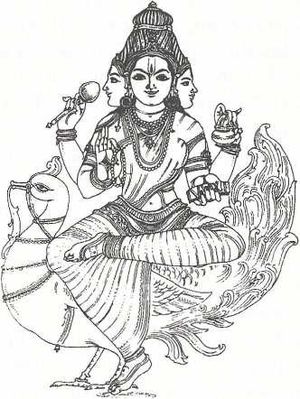Brahmāṇi
By Swami Harshananda
Brahmāṇi literally means ‘the spouse of Brahmā’.
According to the Śakti-cult or the cult of the Divine Mother, each of the major gods of the pantheon has his śakti or power portrayed as the female consort or counterpart. These counterparts of god are with a similar form, weapons and vehicle.
Brahmāṇi, also known as Brāhmī, is the śakti of Brahmā, the four-faced god of creation. According to the Durgāsaptaśatī, one of the basic texts of the Śakti-cult, when Kauśikī Durgā was fighting with the demon Raktabīja, whose blood if spilled could produce demons similar to him, she manifested seven emanations out of herself. These are usually called the Saptamātṛkās or ‘Seven little Mothers’. Brāhmī or Brahmāṇi is the first among them.
According to the Matsyapurāna, when Brahmā was in deep meditation, his pure body divided itself into two halves— male and female. The female deity came to be known as Brahmāṇi, Sāvitri, Sarasvatī and Īatarupā. Description of Brahmāṇi as per the iconographical works is:
- Brahmāṇi has four faces and six arms
- Her colour is piṅgala or tawny
- She wears a deerskin as an upper garment.
- She holds the rosary, a wooden spoon (sruva), a book and a water pot in four hands
- The other two hands display the abhaya and the varada mudrās signifying granting of protection and boons asked for
- She rides on a swan
References[edit]
- The Concise Encyclopedia of Hinduism, Swami Harshananda, Ram Krishna Math, Bangalore

